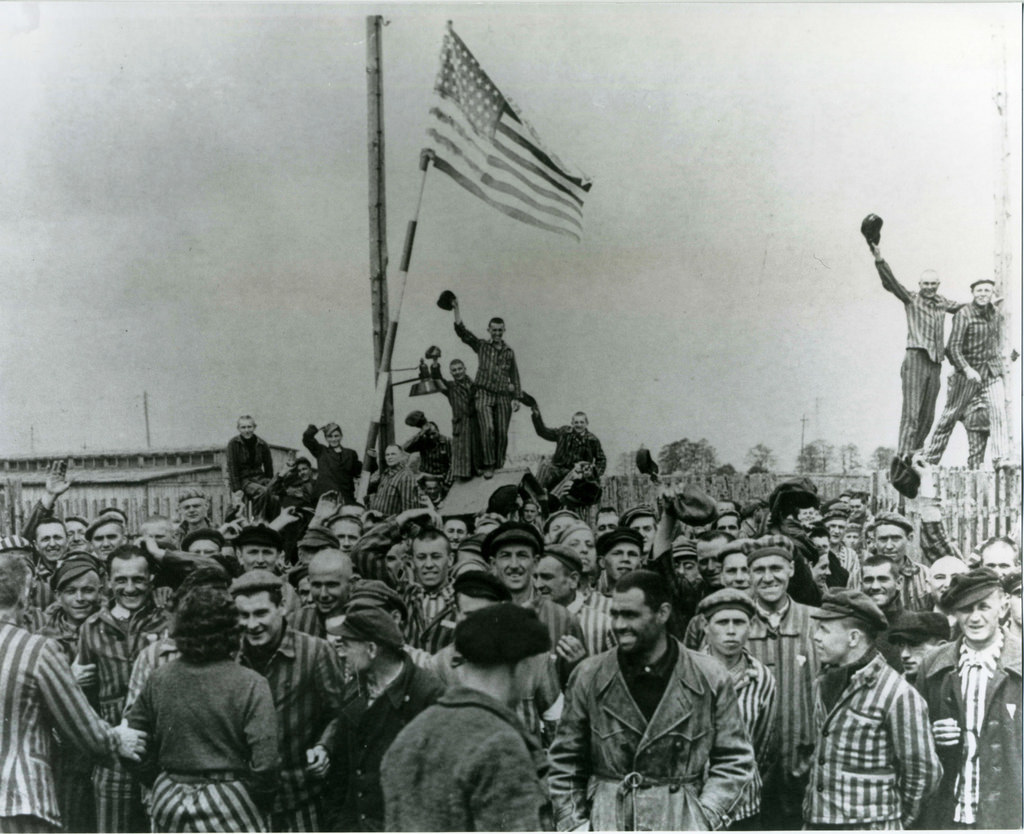
Excerpts from General Sparks personal account of the liberation of Dachau Concentration Camp, edited by Charles V. Ferree
The following is a page from the World War II history book of the 157th.Infantry Regiment, 45th Infantry Division, Seventh United States Army. Dachau was liberated on Sunday, April 29, 1945 by troops from Company I, 157th Infantry Regiment. Thousands of dead and emaciated bodies of civilian prisoners from many countries were within and in the proximity of the Dachau Concentration Camp.
There are no words for Dachau, and even the pictures of its horrors are pale beside its realities.
Veterans of six campaigns to whom death was commonplace, sickened and vomited at Dachau. Not the sight and smell of death did this, but the decaying evidence of human cruelty that was beyond the understanding of the normal mind.
Dachau was rot and stench and filth.
Dachau was Hitler and the SS.
And, deny it though its people did with every breath, Dachau was Germany of 1933-45.
Let Dachau live in our memories…
Chuck Ferree
DACHAU AND LIBERATION
Personal account by Felix L. Sparks Brigadier General, US (Retired)
At 0730 on the morning of April 29th, the task force had resumed the attack with companies L and K and the tank battalion as the assault force. The attack zone assigned to company L was through the city of Dachau, but did not include the concentration camp, a short distance outside of the city.
Company I was designated as the reserve unit, with the mission of mopping up any resistance bypassed by the assault forces.
Shortly after the attack began, I received a radio message from the Regimental Commander ordering me to proceed immediately to take the Dachau concentration camp. The order also stated: “Upon capture, post an airtight guard and allow no one to enter or leave.”
As the main gate to the camp was closed and locked, we scaled the brick wall surrounding the camp. As I climbed over the wall following the advancing soldiers, I heard rifle fire to my right front.
The lead elements of the company had reached the confinement area and were disposing of the SS troops manning th guard towers, along with a number of vicious guard dogs. By the time I neared the confinement area, the brief battle was almost over.
After I entered the camp over the wall, I was not able to see the confinement area, and had no idea where it was. My vision was obscured by the many buildings and barracks which were outside the confinement area.
The confinement area itself occupied only a small portion of the total camp area. As I went further into the camp, I saw some men from company I collecting German prisoners. Next to the camp hospital, there was a L-shaped masonry wall, about eight feet high, which had been used as a coal bin.
The ground was covered with coal dust, and a narrow gauge railroad track, laid on top of the ground, lead into the area. The prisoners were being collected in the semi-enclosed area.

As I watched about fifty German troops were brought in from various directions. A machine gun squad from company I was guarding the prisoners.After watching for a few minutes, I started for the confinement area.
After I had walked away for a short distance, I hear the machine gun guarding the prisoners open fire. I immediately ran back to the gun and kicked the gunner off the gun with my boot.
I then grabbed him by the collar and said: “what the hell are you doing?” He was a young private about 19 years old and was crying hysterically. His reply to me was: “Colonel, they were trying to get away.”
I doubt that they were, but in any event he killed about twelve of the prisoners and wounded several more. I placed a non-com on the gun, and headed toward the confinement area.
It was the forgoing incident which has given rise to wild claims in various publications that most or all of the German prisoners captured at Dachau were executed. Nothing could be further from the truth.
The total number of German guards killed at Dachau during that day most certainly not exceed fifty, with thirty probably being a more accurate figure.
The regimental records for that date indicate that over a thousand German prisoners were brought to the regimental collecting point. Since my task force was leading the regimental attack, almost all the prisoners were taken by the task force, including several hundred from Dachau.
During the early period of our entry into the camp, a number of company men all battle hardened veterans, became extremely distraught.
Some cried, while others raged. Some thirty minutes passed before I could restore order and discipline. During that time, the over thirty thousand camp prisoners still alive began to grasp the significance of the events taking place.
They streamed from their crowded barracks by the hundreds and were soon pressing at the confining barbed wire fence. They began to shout in unison, which soon became a chilling roar.
At the same time several bodies were being tossed about and torn apart by hundreds of hands. I was told later that those being killed at the time were “informers.”
After about ten minutes of screaming and shouting, the prisoners quieted down. At that point, a man came forward at the gate and identified himself as an American soldier.
We immediately let him out. He turned out to be Major Rene Guiraud of our OSS. He informed me that he had been captured earlier while on an intelligence mission and sentenced to death, but the sentence was never carried out.
Within about an hour of our entry, events were under control. Guard posts were set up, and communications were established with the inmates.
We informed them that we could not release them immediately but that food and medical assistance would arrive soon.
The dead, numbering about nine thousand, were later buried with the forced assistance of the good citizens of the city of Dachau.
On the morning of April 30, our first battalion resumed the attack towards Munich.
At this point, I should point out that Seventh Army Headquarters took over the actual camp administration on the day following the liberation.
The camp occupation by combat troops after that time was solely for security purposes. On the morning of April 30, several trucks arrived from Seventh Army carrying food and medical supplies.
The following day, the 116th and 127th Evacuation Hospitals arrived and took over the care and feeding of the prisoners.
END
*************************************************************
In a letter from General Sparks mailed to me from his home in Lakewood, Colorado on March 13, 1997, the General writes:
“Note: The actual body count of dead German guards killed at Dachau (by machine gun fire) was 30. This count was made by the Inspector General who conducted the investigation. The wall at which the men were killed contained 22 bullet holes. This count was also made by the Inspector General.”
Charles V. Ferree
“Let any doubter, in all the generations to come, contemplate what it would be like to live in a world dominated by Hitler, the Japanese warlords, or any other cruel dictator or despot.”
IRA C. EAKER Commanding General, United States Eighth Air Force



